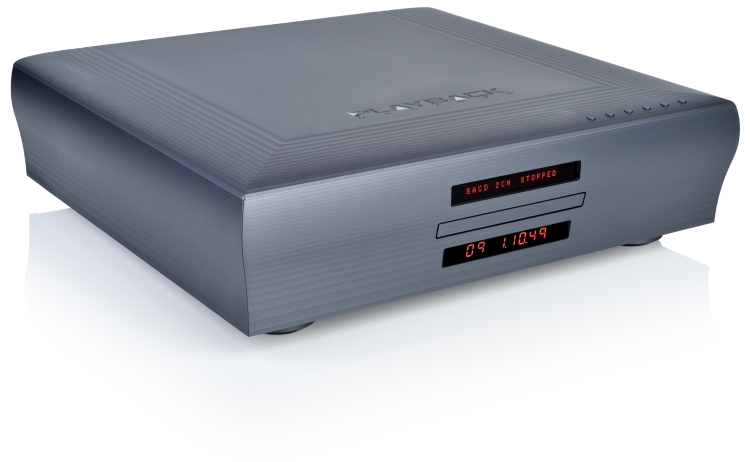PS Audio PWD (Perfect Wave DAC) – part 1
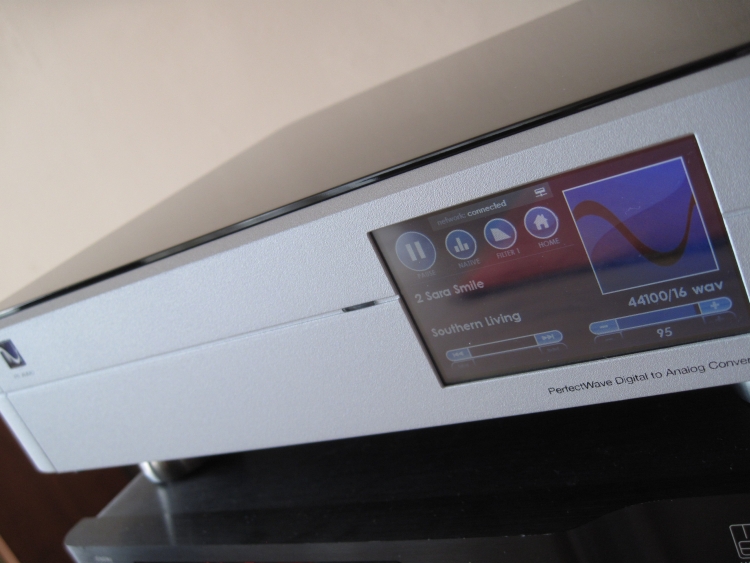
The PWD has long been on my list of things to do but there was such high demand for this unit that I couldn’t get one in for a review
Or maybe I just wasn’t persistent enough… Either way, when I found a nice offer on the second-hand market I decided to just buy one for myself. After all, it is something of a benchmark: after the Linn Klimax DS, the PWD is the first product that approached network audio streaming with high-end playback in mind.
There is so much to say about the PWD that I am going to publish this review in installments. It will be updated continually, as my impressions add up.
First I think that I should say a thing or two about its functionality. Fear not, I’m not going to bore you with marketing talk and besides, by now you’ve probably read enough promises and praise about it already. It is my intention to only globally touch on what it does but to go into detail as to how well it performs its tasks. But the most important aspect of any review I write in general, and this review in particular, will be the sound quality. Will it be better than the best PC-USB Interface-DAC solution I could assemble? Will it finally entirely beat the best reference CD player I ever had? This all remains to be seen, but after my first listening impressions I can already say that the PWD is indeed very, very promising.
As you could read in the header, there is a lot to write about the PWD. There is much to say, not only because it is a multi-functional device, but also because it can be operated in a number of ways, can make use of various libraries on any computer-device or NAS (network attached storage). The connection in case of NAS needs to be ethernet but you can also use the PWD as a regular USB dac by connecting it directly to your computer. The computer will then be the controller and the PWD is then only a dac. There are lots of options and settings, such as whether or not to install the Network Bridge. Additionally, the software and computer type you choose to use for the library and control, also add their own list of options. Finally, I have just received the PWD some days ago and have thus far only tried it in combination with one server solution, installed on a MacBook Pro, When I started writing this review I didn’t even have a NAS yet because, you guessed it, there are many options for a NAS, too. All this combines in what will probably become a very, very lengthy article, hence my decision to publish this review in installments. It is my hope that my writing down everything I learn from the PWD will provide an interesting and entertaining review.
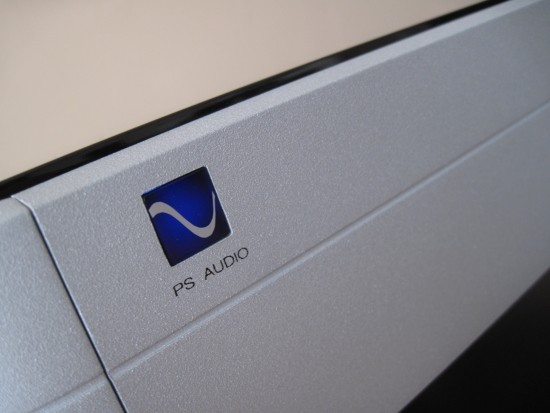
The PWD’s display is simple but intuitive and clearly legible. The brightness can also be adjusted: throughout the review, it was on medium brightness. Although there are track skip buttons, they are not operational yet. The play button does work, and so does the volume control, and all other menu items. Artwork is shown, but not always, and I have yet to figure out the variable. The PWD’s top surface is so very smooth and shiny that it resembles a glass plate but it is in fact painted MDF. So, while it looks splendid, I fear that it might be sensitive to scratching.
Principle explained
The PS Audio PWD is, in essence, a high-performance multi-purpose DAC with built-in network functionality. The thing is, even though network functionality is built into its operating system, you still have to install an optional (around 600 euro) network card, called “The Bridge” before you can actually connect the PWD to you network via ethernet. There is an additional USB port on the Bridge but this is for service use (upgrades) only and you can’t see attached music containing USB drive. You don’t need the Bridge if you want to connect a computer directly via USB. But by taking that route you are merely using the PWD as a DAC while the computer still handles and plays the file, with all related problems. By using the Bridge, you avoid any computer interaction because the computer (or any DLNA NAS) is then reduced to a server, merely sending chunks of data while the PWD decodes the data and actually plays back the music file. What’s more: using the PWD this way, you also make use of their so-called “digital lens”, which cleans up the signal in a clever proprietary way: the clock is stripped and replaced with a brand new, very stable, jitter-free one. But the timing is decided in a very clever way, but this isn’t advertised on the PS site and I only know it from hearing Paul tell us so during a show. Paul’s explanation was a bit difficult to fully understand and will be difficult for me to replicate. But I’ll try nevertheless. The clock is retrieved by taking in a large chunk of data in memory and looking at what the average clock should be over a long period of time. This contrasts with other solutions, that are continuously checking, and constantly vary timing. Apart from this clever Digital Lens, judging from the specs, the PWD doesn’t appear all that extraordinary and at first glance, it isn’t obvious why it should cost so much more than other streaming solutions. That is, until you listen to it. The presence of the Digital Lens was a big part of my deciding to want it. The second argument was the fact that this dac is able to treat clock and data separately (I2S) and the third argument is tied in with the second in that it correlates with my experience that integrated CD players tend to sound better than separate transports and dacs, and therefore, the PWD, as an integrated audioplayer and dac, should also sound better than any solution that carries the signal via spdif to a separate DAC. The PWD isn’t only a streamer; it’s also a very good dac. One that incorporates an upsampler and offers the freedom to choose whether or not you want to use it. You can choose ‘Native” which means that the upsampler isn’t in the signal path, or you can choose any sample rate up to 192khz. In addition, you there are 5 filter settings to tailor the sound, varying from precise and fast to gentle and smooth. This functionality reminds me of what the dcs Delius offered to great effect. Additionally, the PWD offers volume control. It is not mentioned whether this is implemented analog or digitally, but I quickly heard that you lose a lot of dynamics and physical presence by lowering the volume below 90. Given that I always use a preamp, During comparisons, I left the volume at position 95, at which it matched the output from the Mark Levinson no.360S DAC, but during the final listening I set it at 100 because any lower setting lessens apparent dynamic impact and solidity. At this stage it is my hope that the PWD will beat my “Best PC-based solution” that uses a M2Tech HiFace EVO, ST glass cable and Levinson DAC.
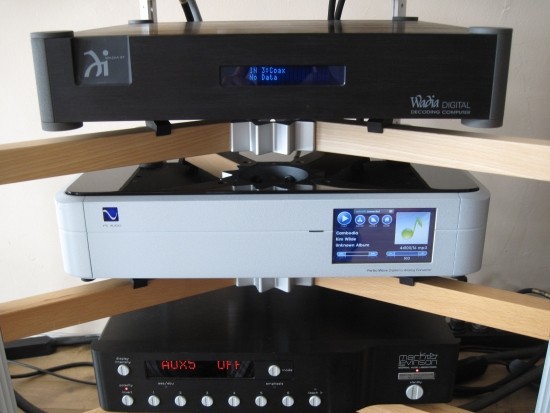
First experiences
Using the PWD as a DAC in combination with the Levinson no.390S as a CD transport
I’ve sold my beloved CEC TL1x transport some years ago when it became clear that the integrated Levinson no.390S beat my CEC, no matter what DAC I used: Wadia, Audiomeca, dCS; it didn’t matter, the Levinson was always more musical and more coherent. Now that I have the PWD is the first time that I regret having sold the CEC as it was a perfect opportunity for me to test the PWD’s DAC quality. Alas, the Levinson no390S will have to do. Mind you, this one is an excellent cd player when used on itself, but for some reason, it never works well as a transport into either of the aforementioned DACs. Nonetheless, I had to try it as a transport into the PWD. I connected spdif via a Wireworld Gold Starlight III+ and played some music I know well. The first aspect that struck me was that its sound was incredibly dynamic and very well articulated, a little dry in the treble but without tipping over into sterility. Also the PWD had very stable imaging and nice, solid bass. Beyond this, I couldn’t assess the sound into more detail because here again, the Levinson showed its incapability to function better than average as a transport and the PWD is not to blame. There was something too shut in and too calculated about the sound and it wasn’t as musical as it should be. But this always happens when using the 390S as a transport. Perhaps it’s a jitter thing, or the way its digital output is devised. Either way, what was heard thus far, was very promising, but I wanted more, so I quickly proceeded to listening via the network.
update july 2011:
Here’s a quick jump into the future: After having switched off the 390S for a prolonged period it suddenly had some problems such as noise on the analog outputs. Also, while the other dacs locked just fine, the Wadia DAC wouldn’t lock onto the digital output anymore. I later learned that the power supply in the 390S was most likely due for an overhaul and shortly after finishing this review was sent in for repairs. This may definitely have had to do with its digital output being less than stable. Perhaps the analog output was last to go? It had sounded splendid up to this point. At the end of the review I also used a Marantz CD80 as a transport into the PWD and that worked very well, producing predictable results in line with other experiences with other dacs. The CDM1 mechanism inside the CD80 always works well but still I found the PWD to sound much better using the bridge.
Trouble in Paradise
After the initial good results using the PWD merely in the role of a traditional DAC, I had some trouble getting the PWD to connect to the network. In a deviation from my normal behavior, I did read all manuals but did’t find the answers I needed. The Bridge Quick Start Guide goes into detail mainly for matters concerning the software installation, getting the server up and running, understanding the functionality and getting basic network matters in order. But it’s all very basic indeed and nothing indicated that I had to do anything special. Moreover, when it came to the connection of the PWD, the manual made believe that it was simply a matter of plug and play. Insert LAN cable, making sure that the PWD was on the same domain as the server (or in my case: the computer running PS Audio’s eLyric Server Program) and that would be it. But for me no such luck. The PWD kept displaying “disconnected” in its Bridge section of the display. Now, my PWD was bought second hand and I probably should make new settings but I couldn’t find instructions anywhere in PS Audio’s documentation. Eventually, I found a post in the PS user community forums that mentioned a trick to reset the Bridge in case it was unresponsive. This entailed touching the display while the PWD was booting and selecting “reset” or something similar at some stage during boot. By doing so, I had indeed reset the bridge but still, I was kind of lost as to how the network settings needed to me made. The PWD’s menu structure is very logical but for some reason I couldn’t quite figure it out at first. There are basically three options in the network settings. There is manual IP, where you have to specify a set IP address and associated subnet mask, Gateway and DNS, then there’s DHCP which lets the router assign these values and then there’s Wireless, indicated by the familiar icon. Now, to my knowledge, the PWD doesn’t have wireless built in but it is optional using a USB stick style wireless transceiver. But, apparently, I was a bit absent-minded when I first connected the PWD because it confused me that the section under the wireless icon kept mentioning WPS-Idle and SSID-Not Connected. It didn’t help either that none of my i-Devices recognized the PWD at this stage. Using eLyric on the iPhone and iPad, the eLyric library that was residing on my Macbook Pro was recognized without problems and music could be streamed to the iPhone and iPad without problems. Because the PWD wasn’t seen as a Media Renderer on either the iPhone or iPad, and considering that there was still a “not connected” message on the PWD’s window, I figured that these things must have something to do with each other.
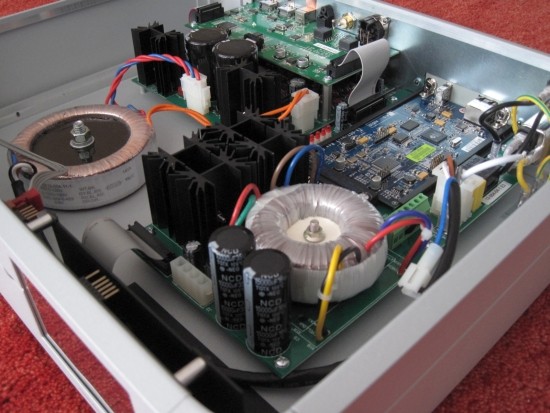
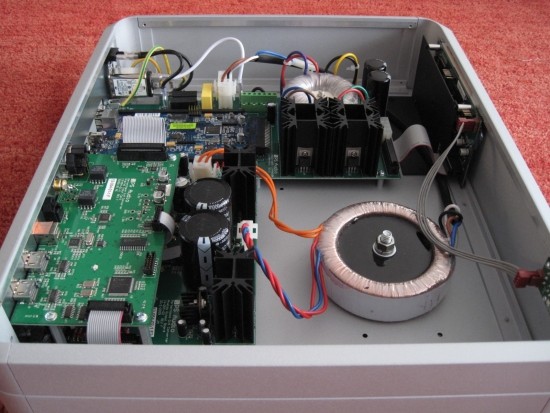
First results with network audio playback
It wasn’t until much later that it finally hit me; that wireless was optional and that my wired network didn’t require a password. Stupid me. Still, the PWD wouldn’t play for me. I can’t remember what I did but it involved resetting routers/switchers/computers and the PWD itself. Eventually, the PWD showed up in the Media Renderer devices list of both iPad and iPhone. And lo and behold: It could play music as well. Immediately it was evident that the sound quality was astonishing – much, much better than my best effort at computer audio replay thus far. But I don’t know what I did, or whether I even did anything to mess it up, but at some stage, the PWD disappeared again from the devices list on both iPhone and iPad.
More trouble in Paradise
At some stage it occurred to me that there may have been an IP conflict so I chose to assign a fixed IP address to the PWD. Again, after some fiddling, it was recognized again, but only to disappear again every now and then. Thus far, the PWD’s network operability hadn’t proven very stable. But eventually I found out what was one of the main reasons why the app on the iphone would crash and why the network connectivity would sometimes be lost: still an ip conflict indeed! As it turns out, the iphone and ipad have a tendency to stick with an ip address, once they have used it before. Upon switching them on, they will try to get that same ip address again, even if that means stealing it from another computer. On top of this, I created problems myself, by assigning specific fixed ip addresses to several devices, but leaving some on DHCP (automatic assignment by the router). As I explained, the iphone and ipad have a tendency to favor an IP address that they used before. To counter this, I restarted both the iphone and ipad and noticed that they took on different IP adresses. But I didn’t take into account that the Macbook wasn’t only connected via ethernet: it was also connected wirelessly. And the wireless connection didn’t have a fixed IP address. That’s not handy either because by doing so you would prohibit the computer to work on any other network than your own. The Macbook is almost always on. This means that it already has chosen an IP address that was free at the time that it was switched on. It so happened that it took an address that I also assigned fixed to the other computer and after I switched that one on, I got an IP conflict that triggered at least some of the aforementioned problems. Once I had this figured out and made sure that there would no longer be a chance of a conflict, I still experienced the odd crash or disconnection of the network. The thing is that I never had any network issues before the PWD arrived. Also, the Olive 04HD music server that I also have here, not once had a network problem and is very stable in use, also in combination with the iphone application. But the Olive is limited in many aspects, not least of which the sound. I am tempted to point to the software that is still in development. Sure enough: PS is still working hard at perfecting the firmware of both the PWD itself as well as the Bridge. I am confident that the stability will improve over time. By the way: installing new firmware is very simple and is described on the PS website.
Allright, enough about networks, IP addresses and conflicts. Instead, let’s proceed to more interesting reading: to find out exactly how the PWD performs when streaming.
The Sound of Network audio on the PWD
My first experience with the PWD playing network audio, was with PS Audio’s eLyric server program running on a Macbook Pro. I would later also install it on a Windows PC and even later on a Synology NAS. Networked audio, using the bridge makes for a different sound than using the regular digital inputs. Not only by using the Levinson no.390S as a transport, but also when comparing the digital output from the PC (using my best PC based solution) to the network audio, both coming from the same PC and both going into the PWD. Invariably, the Bridge input sounds much more solid and 3D, much more musical and more fluid. Also, the soundstage is both wider and deeper as well as leaping more toward the listener. It sounds a lot like the experiment I did with my Wadia 861 and what they call “clocklink”. When I took out the signal from the transport and fed it back into the player while comparing clocklink on or off, there was almost exactly the same difference as heard with the PWD. I think it is safe to assume that we’re talking about the audible effects of jitter here.
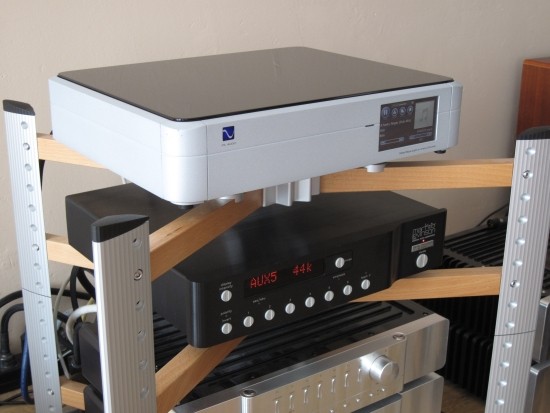
Compared to the Wadia 861
While on the Wadia subject, from memory, it is uncanny how much the PWD resembles the Wadia sound! Like the Wadia 861, the PWD is solid, articulated, dynamic, times well and is extremely life-like in that there isn’t the slightest synthetic signature. Like the Wadia, the PWD has a large soundstage and is very engaging to listen to. Also, like the Wadia, the PWD’s treble lacks that last bit of air, no matter which filter is selected. And that’s strange because the Apodising filter (nr.1) is also used by Ayre and in that application sounded very very open and airy. Don’t get me wrong: the PWD is very open and detailed, perhaps even almost to the Wadia’s standard, and the treble is as detailed as it gets, but it isn’t the smoothest treble I ever heard nor is the the most extended. The lower treble is very open though, and for many listeners, the PWD probably won’t sound like it is lacking air at all.
Compared to the Levinson no.360S and 390S
Compared to both my Levinsons, the PWD has distinctly less air. Not only I heard this: two audio buddies heard it too. But not only is some air missing compared to the Levinsons; they also have much smoother, more liquid treble as well as slightly more color. They just sound more highend. But that’s not to say that the Levinsons win out as they have some areas in which they perform significantly less well than the PWD. For starters, the PWD has better articulation throughout the bass and midrange. It is also more solid and much more dynamic and lively. But the most striking difference was in the way that the PWD managed to project a living, breathing event in my listening room, much like the Wadia 861 is so well capable of. The result is of a foot-tapping, singalong, highly engaging presentation. This is difficult to put in words but easy to hear and can be summed up by saying that the Levinson DAC is more refined yet more withheld and dynamically flatter and the PS is less refined but more engaging and outgoing. An exception to this is the Levinson no.390S cd player, when used as an integrated player, that is. That way it performs the same magic with CD’s as the PWD does with network audio, which is the living, breathing, highly engaging presentation, but also being extremely refined, smooth and airy at the same time.
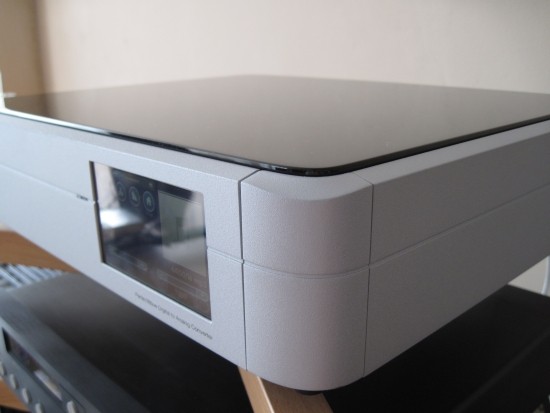
Update July 2011: as the review proceeded, in a later stage I learned about some interesting variables…
This comment was added while writing the second part of this review, by then I had learned a great deal more than I knew in the beginning. By now I have discovered that not only does the hosting server/computer influence the sound; the network cable does too! Choosing the right combination changes things. A lot. Also, the PWD had one little surprise for me. But I won’t spoil the surprise here. Unless you want to go to the Almost Final Conclusion straightaway…
Wolfson
As an interesting side note, the PWD uses a Wolfson dac. Rega does also. And indeed there’s some of the foot-tapping, rhythmic presentation that the Rega also had. Of course there’s much more to dac design and the resultant final sound than the chip used, but there might be a correlation. Most other dacs and cd players I have had sound very smooth, and they used Texas instruments (Burr Brown), Cirrus Logic, Analog Devices and Philips dacs. The Rega and PS Audio use Wolfson don’t sound so smooth, so is that coincidental?
So, while the PWD beats replay via coaxial digital cable into the Levinson DAC; the Levinson CD player ultimately still beats the PWD. That’s not to say that the PWD is flawed: it is more a matter of taste. I have no wife telling me to stop stacking components in my living room so I can afford to keep both solutions around. I use the CD player when I want to experience the best possible sound reproduction and resort to the PWD for all other instances when convenience is more important, which is actually most of the time. And I haven’t even touched yet on the ways to tweak the PWD, for example by choosing the appropriate power cable and interlinks or changing the fuses. This is for the next episode of this review.
